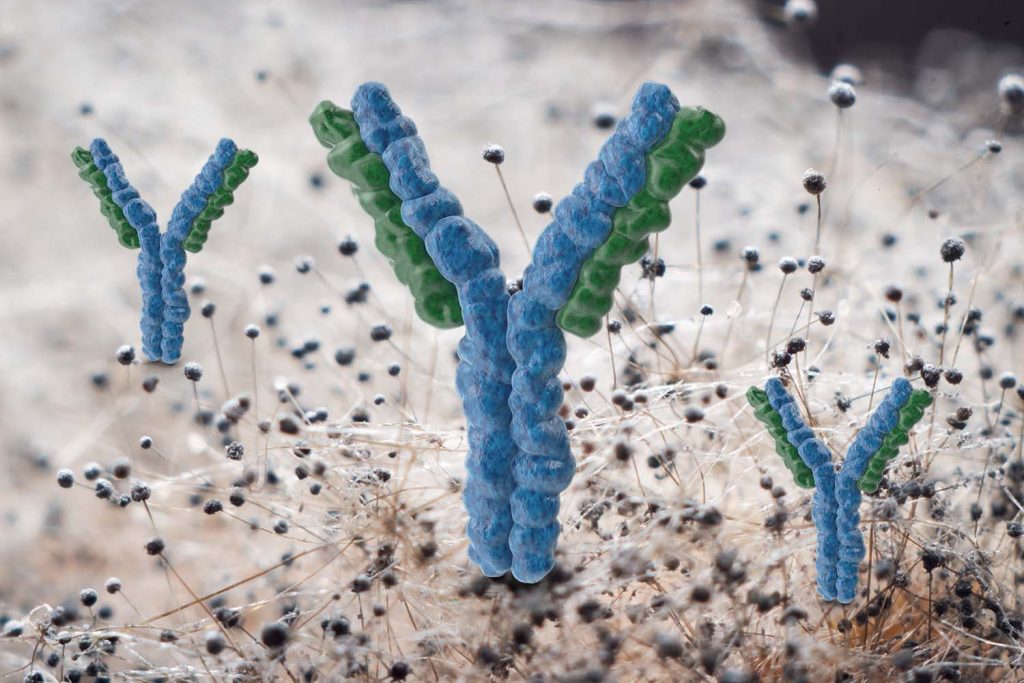26 Apr Low immunity? Mycotoxin contamination may be to blame

The immune system is one of the most affected by the toxicity of mycotoxins. Whenever a situation of low immunity is detected in the farm, the presence of mycotoxins should be suspected in the first place as the cause.
Even at concentrations at which there are no obvious pathological signs, mycotoxins lead to:
- Vaccination failures
- Increased susceptibility to infections
- Poor performance
- Poor uniformity
- Decreased immune organ weights
The immunosuppressive activity of mycotoxins is related to toxicity on the immune cells and to interference with components that regulate immune activities.
Toxicity on monocytes and macrophages
Monocytes are the largest leukocytes (white blood cells) and normally circulate in the peripheral blood. When there is inflammation, tissue damage or infection, they respond to inflammatory signals and arrive within hours to the affected area, where they evolve into macrophages or dendritic cells.
Macrophages are found in all tissues, where they engulf and digest pathogens, cellular debris and foreign substances through a process called phagocytosis. Macrophages also release NO (nitric oxide), a free radical that acts as a defense molecule against infectious organisms.
- Aflatoxin B1, B2, ochratoxin and fumonisins reduce the ability of macrophages to phagocytose and kill pathogens.
- Aflatoxins B1 and B2 reduce the production of NO.
- Aflatoxin B1 stops the cell cycle of macrophages.
- Fumonisin B1 and T-2 toxin promote apoptosis (cellular death) of macrophages.
Toxicity on dendritic cells
Dendritic cells are found in tissues that are in contact with the external environment, such as the skin, the respiratory system, and the gut. The dendritic cells capture antigens from the invading pathogens or foreign bodies, process them, present them on their cell surface, and then interact with T-cells and B-cells, activating the adaptative immune response.
- Aflatoxin B1 reduces the ability of dendritic cells to interact with T-cells.
- Fumonisins impair their maturation and antigen-presenting function.
- T-2 toxin reduces their survivability.
Toxicity on neutrophils
Neutrophils (also known as neutrocytes or heterophils) are the most abundant type of white blood cells. Neutrophils are normally found in the bloodstream. At the starting phase of inflammation, neutrophils arrive to the affected site within minutes, where they ingest microorganisms or foreign particles through phagocytosis. They also have other anti-microbial functions, like production of ROS (reactive oxygen species, a type of free radicals).
- Aflatoxin B1, zearalenone and deoxynivalenol reduce the ability of neutrophils to arrive to the affected site
- Aflatoxin B1, ochratoxin and Deoxynivalenol impair phagocytosis
- Aflatoxin B1 reduces the production of ROS.
Effects on antibody production
Antibodies are produced by specialized white blood cells called B lymphocytes (or B cells).
- Depending on the dose, frequency, and duration of exposure, deoxynivalenol will either reduce or stimulate antibody production.
- T-2 toxin, fumonisins and ochratoxin A decrease antibody production.
Phytogenics help to restore immune function
The best approach to manage mycotoxin risk is to implement an integrated strategy that includes good storing practices of the feedstuffs, frequent mycotoxin analysis, as well as the regular use of a mycotoxin binder.
The inclusion of certain plant extracts helps to counteract the negative effects of mycotoxins, restoring a healthy immune function. Plant extracts have been shown to;
- Stimulates the activity of macrophages
- Increases antibody production and improves the response to vaccines
- Increases the production of lymphocytes
The use of plant extracts together with mycotoxin binders reinforces the effectiveness of the prevention program and accelerates recovery if mycotoxicosis has already occurred.
Products of choice
BioShield© is a complete solution that protects your animals against toxicity by mycotoxins. It includes:
- Broad spectrum mycotoxin protection (silicates with mycotoxin binding function)
- Phytogenics that preserve liver health, safeguard gut health and activate the immune system.
PlusBind© is a mixture of carefully selected silicates intended for the prevention of diseases and productivity losses related to the presence of all types of mycotoxins. It is indicated in poultry, pigs, aquaculture and ruminants.
The silicates present in PlusBind© have a highly expandable molecular structure. This characteristic gives the product a wide surface available for the adsorption of mycotoxins and therefore allows a high effectiveness at lower doses (0.5-1 kg per ton of feed).
PlusBind Bio© is a mixture of carefully selected silicates intended for the prevention of diseases and productivity losses related to the presence of all types of mycotoxins. It also contains plant extracts with prebiotic effect.
It is indicated in poultry, pigs and aquaculture.
The silicates present in PlusBind Bio© have a highly expandable molecular structure. This characteristic gives the product a wide surface available for the adsorption of mycotoxins and therefore allows a high effectiveness at lower doses (0.5-1 kg per ton of feed).
Do not miss any of our articles!
Subscribe to our monthly newsletter

Certain health statements may not be applicable in your region.

